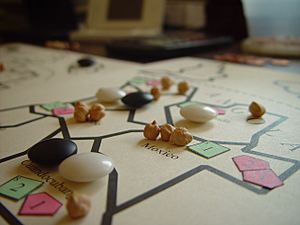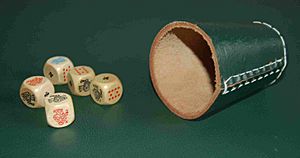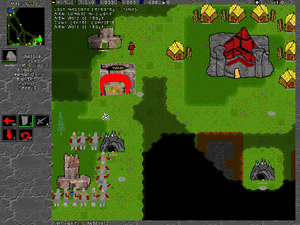Game design facts for kids
Game design is all about using design and cool ideas to create a game. Games can be made for fun, learning, exercise, or even experiments! More and more, game design ideas are also used in other areas, which is called gamification.
A game designer named Robert Zubek says game design has three main parts:
- Mechanics and systems: These are the rules and objects in the game. Think of them as the building blocks.
- Gameplay: This is how you, the player, interact with those rules and objects. It's what you actually do in the game.
- Player experience: This is how you feel when you're playing the game. Is it exciting? Challenging? Fun?
Game design helps make all sorts of games better, like board games, card games, dice games, role-playing games, sports, and video games.
Contents
History of Game Design
People have been playing games for a very long time! Sports have been around for at least 9,000 years. Gambling games are at least 6,000 years old, and board games have existed for at least 4,000 years.
Games That Evolved Over Time
Many classic games we play today, like chess, Go, backgammon, and mahjong, have been around for ages. Their rules weren't written down until more recent times. Instead, they slowly changed and grew over many years, like a story passed down through generations. This is called the "folk process." Because of this, these games don't really have one single designer.
Later, when companies started publishing games, many of these folk games became commercial products. For example, the dice games Generala and Yacht eventually led to the popular commercial game Yahtzee in the 1950s.
Many modern party games like Taboo or Pictionary also come from older traditional games. Changing these old games to make them new commercial ones is a great example of game design!
Just like games, some sports like soccer and baseball grew through the folk process. But others, like basketball, were actually invented by someone specific, like James Naismith in 1891.
New Ways to Play
Throughout history, new technologies have always brought new ways to play games.
- The printing press made it easy to mass-produce playing cards, leading to many new card games.
- Detailed maps helped make wargaming popular.
- Cheap books and cardboard led to mass-produced board games with custom boards.
- Small lead figures helped create miniature wargaming.
- Computers made computer games popular, which then led to video game consoles and many more video games.
- Today, smartphones have brought us tons of mobile games.
Often, the first games on a new technology are just new versions of older games. For example, Pong, one of the first popular video games, was just like table tennis. Later games then start to use the special features of the new technology. Both adapting old games and creating new ones for new technologies are part of game design.
Elements of Game Design
Games can be described by what you do as a player and what you experience. This is often called gameplay. The main parts here are the tools and rules that set up the whole game.
Tools for Playing
Games are often grouped by the things you need to play them. This could be miniatures, a ball, cards, a board and pieces, or a computer. Balls have been popular game tools for a very long time, leading to popular ball games like rugby, basketball, and football. Other tools are special to certain places, like different kinds of playing cards in Europe.
Many game tools are like tokens that stand for other things. A pawn on a board, play money, or even a point you score are all examples of tokens.
Some games, like hide-and-seek or tag, don't use any obvious tools. Instead, how you play them depends on the environment. Hide-and-seek in a school is different from playing it in a park, even with the same rules!
Developing the Rules
While games are often known by their tools, their rules truly define them. If you change the rules enough, it usually becomes a "new" game! Rules usually decide things like whose turn it is, what players can and can't do, what each player's goals are, and how game pieces interact.
How to Win
Common ways to win a game include:
- Being the first to get a certain number of points or tokens (like in Settlers of Catan).
- Having the most tokens at the end of the game (like in Monopoly).
- Putting your opponent's pieces in a certain situation (like checkmate in chess).
- Reaching a certain point in a story (common in role-playing games).
Single or Multiplayer Games
Most games need more than one player. But single-player games are special because the challenges you face are different. Instead of playing against other people, you might play against the game's environment, against your own skills, against time, or against chance. This is also true for cooperative games, where all players work together to reach a common goal and win or lose as a team.
Some games that are called "single-player" or "cooperative" are more like puzzles. They don't involve thinking about what an opponent might do. However, games where you play against computer opponents (using artificial intelligence) do involve strategic thinking.
Story and Plot
Games can tell stories through their mechanics and your choices as a player. Game stories usually have a clear and simple structure. The choices made by the game designer often really change the story. For example, if a game temporarily stops you from directly affecting the plot, it might be a way to show a character feeling sad or helpless.
Luck and Strategy
A game's tools and rules determine if it needs skill, strategy, luck, or a mix of these.
- Games of skill involve physical skill (like wrestling or target shooting) or mental skill (like checkers and chess).
- Games of strategy include games like checkers, chess, and Go. These often need special equipment.
- Games of chance include gambling games like blackjack or roulette, as well as games like snakes and ladders and rock, paper, scissors. Most of these use cards or dice.
Most games have a mix of these elements. For example, American football uses both physical skill and strategy. Many card and board games combine all three: mental skill, strategy, and a bit of chance. Think of games like Risk or Settlers of Catan.
Games as Learning Tools
Playing games is a great way for children to learn! Through play, kids can develop social skills, thinking skills, grow emotionally, and gain confidence to try new things.
Young children learn best by:
- Playing
- Being with other people
- Being active
- Exploring new things
- Talking to themselves
- Communicating with others
- Facing physical and mental challenges
- Being shown new things
- Practicing skills
- Having fun!
Play helps children learn facts and develop social skills and a desire to learn. When kids play, especially in real-life or imaginary situations, it can really make them think. Adults can help by giving support and feedback when needed during play-based learning.
How Games Are Developed
Game design is part of a game's journey from an idea to its final version. This process usually involves lots of testing and making changes.
The Development Team
Game Designer
A game designer (or inventor) is the person who comes up with the game's main idea, its core rules, and how it works. They often also create the game's name and theme.
Game Developer
A game developer is the person who works out the smaller details of the game's design. They also manage the testing and make changes based on what players say. Often, the designer is also the developer. For bigger games, like collectible card games or most video games, a team of people works on it, and the designer and developer roles are split up.
Game Artist
A game artist creates all the visual art for a game. For video games, they are responsible for everything you see on screen. Artists are super important for role-playing games, collectible card games, and video games.
From Idea to Game
Concept
A game concept is a quick idea for a game. It describes how you play, who the players are, and how you win or lose. This idea might be "pitched" to a game publisher, just like movie ideas are pitched to producers.
Design
During the design phase, the game concept gets filled out. The rules are made clear, including what components are needed (boards, cards, on-screen items). The order of play, possible player actions, and how the game starts and ends are all defined. For video games, designers might create storyboards and mock-ups of what the screens will look like.
Prototype
A game prototype is an early, rough version of a game used for testing. Making a prototype usually means the project is moving from just designing to actually developing and testing the game. Prototypes are great for trying out new game ideas and technologies.
Testing
Game testing is a huge part of game development. During testing, people play the game and give feedback. They talk about how the game feels, if the pieces are easy to use, if the rules are clear, how easy it is to learn, and if it's fun. The developer then changes the design, pieces, look, and rules, and tests it again. Later, groups of people called "focus groups" might test the game to see how consumers react before it's released.
During testing, problems with game balance might be found, which means the design needs to be changed. For video games, testing is all about finding and fixing "bugs" (software problems).
Different Types of Games
Different kinds of games have different design challenges.
Board Games
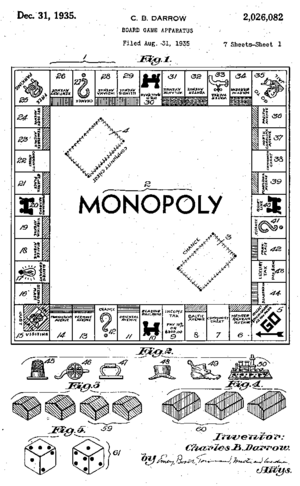
Designing a board game means creating its rules and how it looks. When you play a board game, you agree to follow its rules, which gives the game a purpose. The goal of board game design is to keep players interested throughout the game. Designers focus on things like social interaction, strategy, and competition. They also think about whether the game should be short or long, and if it should rely on luck or skill.
The oldest known board games are over 5,000 years old. They often have simple rules and are more abstract. Games like Go and chess have changed their look and rules many times over the centuries.
Older board games from the 1800s and early 1900s were often made to teach lessons, like history or good morals. Some early American game designers even avoided using dice because of old beliefs! Even games like Monopoly (based on The Landlord's Game from 1906) were originally meant to teach about political ideas. By the 1930s and 1940s, board game design started to focus more on just having fun, and characters from comics and TV shows began appearing in games.
More recently, in the 1980s, new types of board games called "German-style board games" (or "Eurogames") became popular. These games focus on giving players meaningful choices. They often reduce luck and emphasize skill, strategy, and competition for resources. They also try to make sure players don't fall too far behind early in the game. This idea of "elegant game design" is about making games with fewer rules and choices, but still lots of depth.
Modern technology has made it easier to create board games. Websites like Kickstarter help designers get money to start, and 3D printers can help make game pieces and prototypes.
Card Games
Card games include those with special cards made just for the game, and those that use standard decks like Tarot or regular playing cards. Card games can be played just for fun, like Go Fish, or for gambling, like Poker.
In some Asian cultures, special tiles are used instead of cards, like in mahjong. Western dominoes are thought to have come from Asian tile games.
Sometimes it's hard to tell the difference between card games and board games. Many card games, like solitaire, involve arranging cards on a "tableau" or playing area. And many board games use special cards for random events (like the Chance cards in Monopoly) or as the main way to play.
Because cards are usually shuffled and revealed slowly, most card games involve some randomness and hidden information (like the cards in your hand). This is different from many board games where most of the game is visible to everyone.
How players play their cards, revealing information and reacting to previous plays, is key to card game design. In team card games like Bridge, rules about how players on the same team can communicate are an important part of the design.
Dice Games
Dice games are some of the oldest games known and have often been linked to gambling. Non-gambling dice games like Yatzy and Yahtzee became popular in the mid-20th century.
Just like with card games, the line between dice games and board games can be blurry. Dice are often used to add randomness to board games like Monopoly or Risk. But in games like Backgammon, dice are the main way the game is played.
Dice games are different from card games because each dice roll is a fresh start; the chances of rolling a certain number don't change based on past rolls. Card game odds, however, change as cards are drawn from the deck. Dice game design often focuses on making scoring combinations and deciding when to re-roll dice.
Role-Playing Games
Designing role-playing games means creating the setting (where the game takes place), the characters, and the basic rules. After a role-playing game is made, players often create even more design elements themselves. For example, players usually create their own characters. Also, the story of a role-playing game is largely shaped by the gamemaster, who might use different theories to guide their game.
There isn't one single main theory for tabletop role-playing games because different people want different things from them. Some want a more challenging game, others want to create a better story, and some want better rules to help build the game world.
Video Games
Video game design happens at the start of video game development. In the video game world, game design means creating the content and rules of a video game. The designer's goal is to give players interesting choices while they play. Parts of video game design like setting up basic gameplay rules create the framework for players. Adding stories gives players a reason to care about playing. To create the rules and story, a consistent game world is built, which needs visual art, sound, and programming for the world, characters, and level design. This often takes a whole team of designers, who might specialize in different areas. To keep everyone on the same page, a special document called a "game design document" guides the overall mood and feel of the game world.
Important parts of video game design are how you interact with the computer (called human-computer interaction) and how the game "feels" when you play it.
War Games
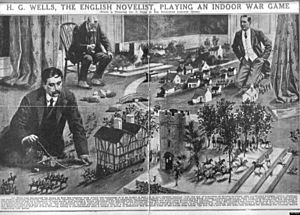
The first military war games, called Kriegsspiel, were designed in Prussia in the 1800s to train army officers. They are also played as a hobby for fun.
Modern war games are used to test military ideas, strategies, and tactics in large exercises with opposing forces. These exercises happen at places like the NTC and involve countries from NATO.
Images for kids
-
All casino games are designed so that the house (the casino) has a mathematical advantage. For a slot machine, the casino's advantage can be anywhere from 2% to 15%.
See also
 In Spanish: Diseño de juegos para niños
In Spanish: Diseño de juegos para niños


